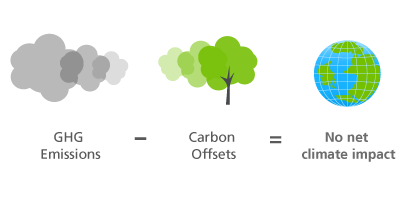Offsetting GHG emissions and going carbon neutral

Carbon neutral (also known as climate neutral) refers to an organization, product, service, event or individual that has reduced the overall net climate impact of their operations to zero. This is usually a 3-part process
- measuring greenhouse gas emissions
- reducing greenhouse gas emissions
- offsetting remaining greenhouse gas emissions
Your company can measure and reduce greenhouse gas emissions with respect to its own operations. In order to go carbon neutral, your business will have to purchase reductions, known as carbon offsets, from another source.
"Carbon neutral" can also mean a goal to be achieved within a set timeframe (e.g. becoming carbon neutral by 2013), which can allow you more time to reach your reductions objectives prior to the set date.
Using carbon offsets to become carbon neutral

Can any business create and sell offsets?
A common question from businesses that find ways to reduce their GHG emissions is whether those reductions can be sold as offsets. It should be understood that developing offset projects is a technical undertaking requiring investment and specialized expertise. For example, offsets should be verified by a qualified auditor according to a recognized methodology. As well, a business cannot sell offsets from its own reductions if it counts the same reductions in its inventory because it would be double-counting the same reductions. Nor would reductions from activities that are already underway or planned to occur be eligible because they would not meet the test of additionality.
Learn more
For more information about carbon neutrality and carbon offsets, read the Doing
Business in a New Climate - This link will open in a new window guide (PDF, 5.72 MB).
Source: David Suzuki Foundation - This link will open in a new window website.
